Sunday May 7, 2017
For: Freshened styling, improved tech.
Against: High seating position, boot size, if Sync’s so good why CarPlay as well?
By Richard Bosselman
First off, this is the long-awaited big mid-life refresh for the Ford Kuga … just don’t call it that.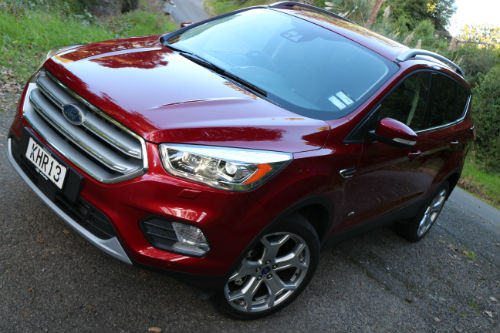
Yes, we all know the vehicle in test today is, quite patently, a facelift of that Focus-derived medium crossover that has been on sale here since 2013.
But no point looking for that (not so special) K badge – it’s held in the same well-secured, deeply-buried vault that holds ‘Edsel’, ‘Pinto’ and ‘Consul’ and other dud names from Ford’s past.
Forget Kuga. The Blue Oval is trying so hard to. Now the car only answers to being called Escape.
Is that enough? Ford NZ reckons a primary reason why Escape’s predecessor was cold-shouldered too often was the controversial name. Yet the top-to-bottom refresh that arrives now also suggests it actually knows the moniker wasn’t the sole issue.
Anyway, forget the past. Ford is looking forward to a brighter future. There’s good reason why Escape will have marketing priority for the remainder of 2017: Last year was when sports utility vehicles began to outsell regular cars – a historic swingshift that very likely won’t reverse. To get back into the race, Ford has set a target of 140-160 monthly Escape sales, or double the Kuga count.
Intention is not just to elevate Escape to become the brand’s top-selling SUV but to also see it achieve top five status within its category, a big improvement over Kuga which ended 2016 in ninth.
That’s why the big mid-life refresh ticks off more than just a badge swap. Way more.
As a big mid-life change, the update also introduces sharper exterior design, restyled interior, revised pricing and a new front-wheel-drive version.
There’s also a technology upgrade - inclusion across all models of the Sync3 entertainment suite with sat nav, voice command and enhanced connectivity is the priority feature but it also now has an electronic park brake, an improved self-park feature and improvements to its driver assistance technologies.
Ford also claims a modest economy improvement effected by implementation of auto stop/start.
Design
A larger grille and a new set of head and taillights not only lend a more confident air and more interesting appearance overall but also brings it into line with other Ford SUV products, notably the street-suited Edge coming out of Canada next year and the more robust Everest wagon.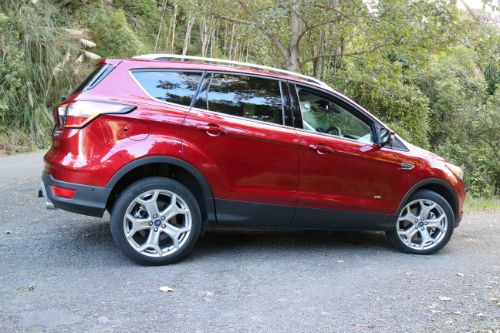
The car continues over three trim levels – Ambiente, Trend and Titanium – the first with a 134kW/240Nm 1.5-litre EcoBoost petrol that avails in front-drive format, the second with that mill or the option of a 2.0-litre in 178kW/345Nm petrol and 132kW/400Nm diesel and the last purely with the larger capacity powerplants, all married to a six-speed automatic transmission, now with paddle shifts. The 2.0-litre models, as before, are all-wheel-drive. Sorry, petrolheads, the 2.5-litre V6 that goes into North America was not cited for right-hand-drive use.
The family has grown from six to seven choices, with addition of a front-drive automatic medium spec petrol; a sought-after specification that, remarkably, Kuga never covered. Prices range from $37,990 through to $54,990 for the Titanium diesel driven here.
Inclusion across all models of the Sync3 entertainment suite, which can read text messages aloud and offers voice control functionality and also supports Apple CarPlay/Android Auto, is the priority feature of the cabin.
Note how we didn’t say ‘new’ cabin there. That’s because, overall, it’s not. No question, the Escape is better outfitted now, but design-wise the interior is very much as before; while there’s a fair bit of redesigning, in general look it’s not too much of a reshape.
The most notable change is the removal of the mechanical handbrake for an electronic unit. Otherwise, they’ve effected less radical alterations. For instance, while the centre console is less cluttered and its infotainment area is cleaner – no more clunky buttons – the overall piece is as before, so the screen remains so recessed it’s difficult to use with confidence (on the move it’s too easy to mis-hit the prompts). It seems a bit weird to me, too, that a vehicle with Apple CarPlay keeps a CD player, in the pillbox atop the dash. The cumbersome air vent design and air vent scroll wheel from the Kuga remains, too.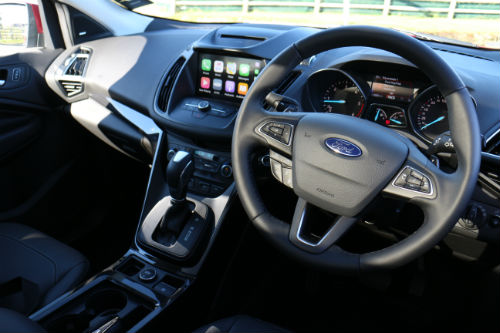
Escape retains good seat adjustment and the steering wheel is tilt and reach adjustable, but high-set bus-style seating position is out of sorts with class trend; nowadays all the newest models win favour from having car-like driving positions.
Old-style feel also comes with the rear seat; there’s good head room and reasonable leg space, but does feel a bit narrow in the rear row. The fifth middle seat is going to be a bit of a squeeze for a large child, let alone any adult. Headroom and legroom are reasonable all round.
The seats feature a lever to adjust the seat’s back position and this helps free up some room for a feature you usually acquaint with passenger aicraftl flip down food trays.
Both outer seats have ISOfix for car seats, with anchor straps located near the bottom behind each seat and hidden behind a flap which requires moving the seat forward to access.
Boot capacity is reasonable at 406 litres but it is awkwardly shaped; to cart a medium-sized dog crate that is simply swallowed by my Subaru Outback I had to fold down one half of the 60:40 split-fold seat.
Technology improvements should be applauded. It also now has an improved self-park feature and improvements to its driver assistance technologies. Active City Braking now works at up to 50kmh and lane-assist which physically steers the car for you if you stray over the white lines is standard to Trend and Titanium.
Escape keeps the same five-star crash test result meted the its predecessor because it now has an auto-stopping function. The Australasian New Car Assessment Programme, which crash tests on the NZ Government’s behalf, has also applauded the car for providing electronic stability control and attention assist.
Driving
When Ford last used the Escape name in this market, it was attached to a version of a Mazda SUV, the Tribute. When the cars were compared, the Hiroshima version just seemed a touch better in the driving and detailing.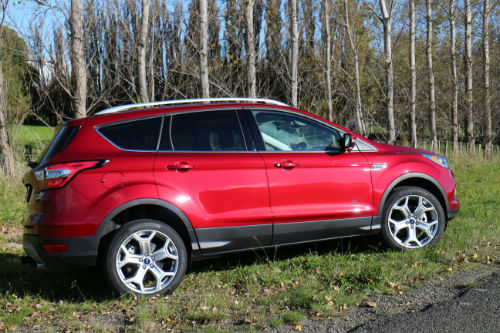
Fast forward almost 20 years and, if you conducted another Ford-Mazda showdown, this time with Escape versus the just-released second gen CX-5 … well, it’s probably not a good idea, actually. The CX-5 in previous format rose to the top of this class and the new one seems set to maintain that dominance.
By all means, however, feel confident about comparing the Escape with the Toyota RAV4, Hyundai Tucson and Kia Sportage and Subaru Forester. It stacks up far more confidently against older designs.
Unsurprisingly, the Escape drives a lot like the Kuga. That’s not a bad thing in most respects. There’s a nice fluency to its driving attitude that translates to decent stability through bends and on metal.
At the same token, despite being derived from one of world’s better handling hatchbacks, it doesn’t deliver the precision that is required to ensure complete driver entertainment.
Despite the body roll system, it is not the most agile of its kind, with some lean when pushed. That’s not necessarily bad; because the suspension has been set up for composed, comfortable ride it rides bumps and ruts quite well. All the same, it does feel a bit frumpy and old fashioned.
The power steering is now fully electric and while it saves on running costs, it has sacrificed feedback.
The auto no longer has that silly switch on the gearstick that was supposed to effect manual changes; now there’s a ‘sport’ setting that enlivens its action.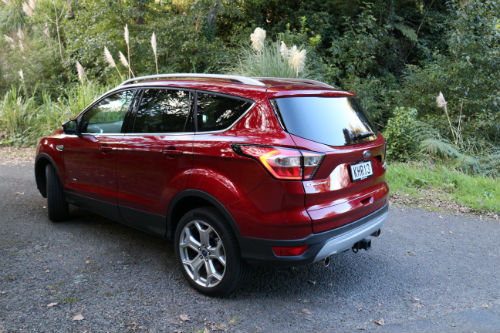
More customers in this category are going back to petrol, yet though Ford’s units are zesty and sound good, the diesel is the one I’d want. The Escape demands decent muscle to overcome its chunky 1700kg-plus kerb weight and while the oiler is no rocket ship, it still offers a better combination of power, mid-range torque and efficiency than the petrol. It’s also smooth and noise is well isolated from the cabin, though so it should be.
With Escape Ford has gone declared total war on road, wind and mechanical noise and implemented double laminated front windows and extra padding in the B and C pillars and around the inside of the rear wheel arch. That’s an expensive approach but it works.
Determination
Something old, something new. The strong engine and outstanding ride are strengths from the old package that carry through to the new. Also transferring are some of the weaknesses: the smaller boot and compromised rear seat. The technology update is impressive and should not be ignored - a lot of those cars are bought by families, after all – and it’s a much better-looking car, now.
All in all, it’s a better contender for consideration, now; however, this is a tough category, there’s plenty of choice and few duds. Being better than before doesn’t make it better than the best. I’d still pick the CX-5.


